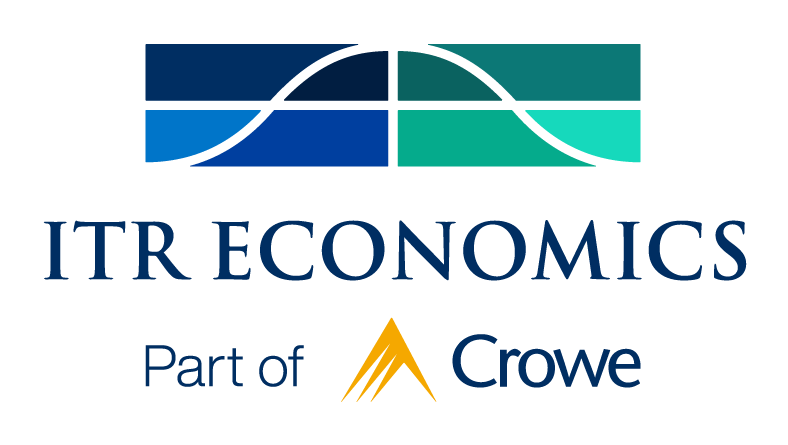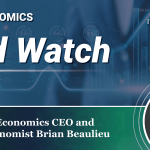April 8, 2024
- Home
- portfolio
- TrendsTalk
- April 8, 2024
CONSUMER INCOME, DEBT, AND SAVINGS
Join us for a new episode of TrendsTalk as host Taylor St. Germain provides an overview of consumer health in relation to our economic outlook for 2024.

MEET YOUR HOST
Taylor St. Germain
As an experienced economist, Taylor St. Germain provides consulting services for small businesses, trade associations, and Fortune 500 companies across a spectrum of industries. His dynamic personality and extensive knowledge of economic trends and their business relevance are highly valued by clients and colleagues alike.
“Join me on the TrendsTalk podcast to explore the world of economics. Episodes offer insightful discussion and expert interviews. We cover relevant economic concepts in an accessible way. Whether you are a curious layperson or an industry professional, TrendsTalk is your go-to source for thought-provoking analysis and a deeper understanding of the economic forces shaping our world.”
Key Episode Takeaways
- 1:06 – Highlighting our economic outlook
- 2:27 – Looking at the long-term trend of US Real Personal Income
- 3:08 – Types of consumers you should be targeting in 2024
- 3:48 – Key metrics we monitor related to consumer debt
- 4:48 – Looking at household debt
- 5:38 – Credit card debt is rising
- 7:39 – Looking at US Personal Savings
- 8:25 – Conclusion and summary
The below transcript is a literal translation of the podcast audio that has been machine generated by Rev.
Hi everyone. My name’s Taylor St. Germain with ITR Economics, and welcome to this episode of TrendsTalk. We at ITR economics are your apolitical and unbiased source of economic intelligence, and today I wanted to revisit the consumer, how the consumer’s doing, where there might be areas of concerns and what it means for our overall economic outlook for this big US economy. We’ll talk about the consumer in a few different ways. We’ll look at income, we’ll look at levels of debt and we’ll talk about savings a little bit here as well. The reason I wanted to bring the consumer back into the conversation is I’ve been receiving a lot of questions from ITR’s clients as of late about should we be concerned around levels of debt in the consumer? Is the consumer contributing to a slowdown in the economy? So hoping to answer some of those questions on this episode here today.
So let’s first start off with a reminder of our economic outlook. We do see GDP slowing in 2024 before starting to accelerate once again into 2025 and 2026. Part of the slowing in GDP is related to the consumer, given the consumer, consumer spending, I should say makes up about two-thirds of our GDP number here in the U.S. But I think we at ITR when we look at the data, might be less concerned than what some of the headlines would read about the consumers, and that’s what I’m hoping to clear up here today. When we look at real personal income, we can look at real personal income including or excluding transfer receipts, but let’s focus on consumer income. That includes transfer receipts. There’s a lot of media attention around consumer income where we’re talking about consumer income being lower today than where it was during the sort of post-pandemic timeframe, and that is the case, consumer income in terms of the level of income you have seen essentially trend down compared to that really post-2020 timeframe, but so much of that was as a result of stimulus checks, right?
Of course, consumer income might be a little bit lower today than when individuals in this country were receiving stimulus checks. I don’t want to downplay that. However, if you look at the long-term trend of real personal income here in the US, we have returned to this overall rising trend. So yes, we’ve sort of come back down to the trend line after these stimulus check impacts, but we’re still growing if you look at the overall trend. So I don’t want you to read too much into what some of the headlines out there might be saying personal income is down. Of course we’re slightly down compared to when these stimulus checks came out, but we’re back on this long-term rising trend.
Now, I do also want to highlight that it’s the higher incomes in this country that are really moving the needle. So as you’re looking to target areas of the consumer, it’s likely that the higher income levels in 2024 will feel less of the pain of a bit of a slowdown. But again, from an overall perspective, we’re seeing this long-term rising trend in consumer income, which is good news for a no recession GDP outlook just slowing in GDP in 2024. So consumer income of little concern to us as the trend looks quite positive from our angle.
Now let’s talk about debt. We look at two metrics very closely when it comes to debt. One is household debt, the other is credit card debt, and these numbers are both as a percentage of median annual earnings. So we’re looking at household debt per capita as a percentage of median annual earnings and credit card debt per household as a percentage of median annual earnings. As we sit here today, that household debt ratio, that percentage is currently 110.9%. And when you hear that, you might be saying, “Wow, Taylor, that sounds like a concerning number.” But you need to put this in historical context. We’ve essentially leveled off around this 111% household debt number since 2013. It’s really been a flat trend all of these years since then, really over the last decade. So even though that number sounds high, it’s really not moving anywhere and it’s consistent with where we’ve been for the last 10 years.
So from a household debt perspective, again, you have to look at different income brackets. They can be more concerning when you look at the lower end of the income bracket here in the US. But from an overall perspective and what it means for the macroeconomy, still a very little concern in terms of a negative impact given this trend has remained flat. Now, credit card debt as again per household as a percentage of median annual earnings is rising unlike the household debt. So that’s something that we are watching closely. Again, to give you some perspective, during the 2021 timeframe, that credit card debt to earnings ratio was about 11.8%. That was the low during this pandemic, early post pandemic timeframe, and as we sit here today, it’s up to about 14.2%.
So credit card debt is rising. However, again, let’s put this in historical context, that 14.2% that we’re at here today is still well below that north of 15% number that we saw during 2019, to give you a pre-pandemic perspective. Yes, it’s worth watching the credit card debt numbers and it’s clear that consumers are taking on a bit more credit card debt. But again, from a historical perspective, it’s below the 2019 level still, and it’s certainly nowhere close to the twenty-plus percent level that we saw in ’08-’09. The way we look at credit card debt is something to watch, but not to worry about just yet.
Another way to look at debt, especially related to credit cards, is the number of consumers making the minimum payments on their credit cards. That number is almost on par with what we saw in 2019 before the pandemic. So the number of individuals making the minimum payment reached a low point at the end of 2021 at about 8.3%. That number has risen to 9.9% on a 12-month moving average as we sit here today. So again, it’s something worth noting. We were at 10% in 2019 before the pandemic occurred. So even though we’re seeing rise in the number of individuals making that minimum payment, are we seeing that at a level that’s concerning compared to historical trends? No. We’re sort of getting back on par with where that number was before the pandemic.
Now again, it’s rising. It is contributing to a bit of a slowdown in some of the consumer markets, so I don’t want to downplay that, but it’s not at a level where we need to worry about a major economic collapse or anything crazy like that. So hopefully that can provide a little bit of perspective.
Now, the one area that we have seen some retreat in the metric since the really 2020-2021 timeframe is the savings balance. So if you look at the savings balance, it’s US personal savings, and it is a deflated series. We deflated this with the consumer price index, so we can strip out that inflation impact and really look at a deflated series. And when we look at that personal savings balance, it did peak in early 2021, and really retreated through ’22 and into ’23. But we’re actually starting to see that rise once again as we sit here today in early 2024. So again, do we have slightly less in our savings accounts today than compared to 2021? We certainly do, but that savings balance, again, is still well above where we were in 2019 before we entered those tumultuous years of the pandemic.
So overall, incomes are still rising, especially in the higher income brackets that tend to really move the needle in terms of spending overall. Household debt has remained flat for really the last decade. Credit card debt and minimum payments are rising but aren’t rising to an area that’s concerning based on historical precedence. And yes, we’re saving a bit less money, but we’re still in a relatively healthy position compared to historical trends.
So overall, yes, there are signs that the economy will slow, especially the consumer portion of the economy will slow in 2024, but are we projecting any major economic downturn, especially on the part of the consumer in ’24? We certainly aren’t. That’s why we still have a positive GDP number when we look at 2024.
So overall, there should be some opportunities out there for businesses that are tied to the consumer, but expect those opportunities to come at a slower pace compared to what we’ve seen in the previous years.
Again, as we get closer to this election and into the election cycle, you’ll see a lot more headlines out there, economic headlines, and it’s important to focus on what the data’s really saying rather than what you see in these headlines because you can get a very different view, different understanding based on looking at actual data.
That’s what we’re here for at ITR. We’ll cut through the noise for you and we’ll give you the facts in the bottom line as it relates to where this big US economy is headed here in the future.
Thanks so much for joining me on this episode of Trends Talk. Just as a reminder, please like and subscribe to TrendsTalk wherever you listen to your podcast, and I look forward to seeing you all on the next one. Thanks for joining me here today.





